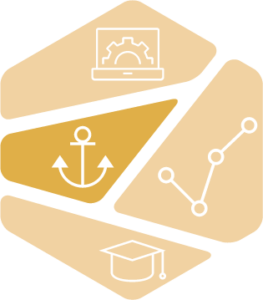Ships’ zero emission in pilot Port of Borg will benefit E-LAND
By Mari K. Buckholm & Marianne R. Kahrs, Smart Innovation Norway 4. November 2019
 Ships using electricity from renewable energy instead of burning fossil fuel is a new and important element that will go into E-LAND’s pilot Borg Harbour (BIKS). Though, the financing of the ship-shore connection project is not a part of E-LAND project, the results will have a big impact on E-LAND, because the design of a multi-vector simulation (MVS) system will have to take this future scenario into account.
Ships using electricity from renewable energy instead of burning fossil fuel is a new and important element that will go into E-LAND’s pilot Borg Harbour (BIKS). Though, the financing of the ship-shore connection project is not a part of E-LAND project, the results will have a big impact on E-LAND, because the design of a multi-vector simulation (MVS) system will have to take this future scenario into account.

Marianne Riddervold Kahrs (Photo: Smart Innovation Norway)
According to calculations, Port of Borg’s consumption will be doubled when ship-shore connections are installed compared to today’s consumption by e.g. electrical cranes, reefers and port lightening. With this scenario in mind, it is crucial for BIKS to be able to simulate using a MVS system and to make investments in solar panels (PV) and other renewable resources.
Large impact
The first ship is planned to plug-in autumn 2020 and will need electricity when berthed. BIKS is making preparation for this and BIKS’ new warehouse 14 has a roof of app. 19 000 sqm, which is constructed to be easily fitted with PV panels.
The ship-shore connection is expected to have an output on effect (kW) and energy use (kWh) that in periods will dominate the electrical system in BIKS. Thus having a large impact on the possibility to utilize PV and all other energy vectors in E-LAND regarding electricity.
Demonstrating E-LAND toolbox

The ship Nexans Skagerak. The company Nexans produce large cables for subsea use, both telecommunications and energy. Their facility close to BIKS is used when huge cables are loaded to the vessel Nexans Skagerak in preparation for laying subsea cables all around the globe. During this work, this vessel may stay for several weeks at port, and will be a large consumer of ship-shore electricity in these periods. (Photo: Smart Innovation Norway)
When PV panels are installed, the resulting DER (distributed energy resource) may then be part of the pilot site of BIKS when demonstrating the E-Land toolbox. Also, as part of E-LAND project, the partner RLI develops a multi-vector simulation tool (MVS). Together with RLI, BIKS will use the case of planning the new DER at its Warehouse 14 as a case during the development of the MVS.
“As the tool and the planning of BIKS’ new DER is done in parallel we look very much forward to getting even more results from the development of the MVS tool”, says Marianne R. Kahrs.
540 tons less CO2 from ships
“At BIKS, we try to make ship-shore connections available to all vessels. The total CO2 reduction from this effort is stipulated at app. 540 tons. The most impact on CO2-reductions we will get from ships that frequent the port regularly and spend significant time at the port”, Marianne continues.
At the local level, boats and ships have significant emissions within a community, both with regards to CO2, NOx, micro particles and other pollutants. For instance, sea transport has calculated that some 7 % of the CO2 emissions in Fredrikstad municipality. There are strong efforts internationally to ensure that vessels use ship-shore connections to replace burning diesel while at port. This strongly reduces CO2 and other pollutants from the vessels.
Thus stronger international legislation is needed to reduce CO2 emissions from ships in international waters.
Port of BorgPort of Borg (BIKS) is a port in southern Norway, and its ambitions in E-land has been to develop and utilize their energy use and production in a more optimal way. Thus, using E-land tools to optimize the use of solar energy, power batteries, electrical charging and minimize the cost of electricity and district heat from the external grids. As of summer, 2019, BIKS was granted funding from Enova to develop ship shore connection in the harbour. The first actual ship is due to have its power supplied from shore, as opposed to making its power on board, next autumn. In addition to the ship-shore connection at BIKS, the harbour also co-operates with other ports to ensure similar installations, to stimulate more vessels to be converted for ship-shore connections. >> Read more about the Port of Borg
|
||
Social media
E-LAND updates

The E-LAND project aims to develop and demonstrate tools for energy systems to overcome the technical, business, and societal challenges associated with the creation of… (1 year ago)

E-LAND exploitation enhancement activities kickstarted for the final project year Multiple events were executed and many more are planned for the E-LAND project’s final year.… (1 year ago)

A central pillar of the E-LAND project's is risk management. The Norwegian consortium member, Institute for Energy Technology (IFE), implemented a risk management approach to… (2 years ago)

E-LAND H2020 is working with creating a toolbox that is designed to optimize and control multi-energy islands and isolated communities. The toolbox is structured in… (2 years ago)

Smart Innovation Norway together with the University of St. Gallen have developed a series of workshops that began in June 2021 and focused on the… (2 years ago)

About the pilot site: Port of Borg is situated in an industrial area on a small peninsula called Øra just outside Fredrikstad, Norway. Port work… (2 years ago)

Since the mid-1960s, the township of Auroville in Southern India has been striving for sustainable living and the realization of human unity in diversity. In… (2 years ago)
